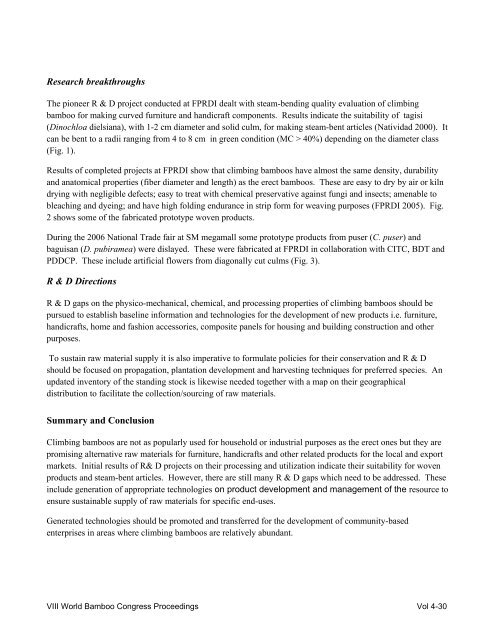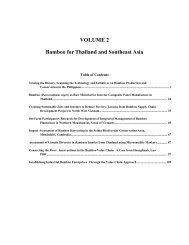WBC-VIII-Vol.4 – Resources – Forestry, Plantations and ... - BambuSC
WBC-VIII-Vol.4 – Resources – Forestry, Plantations and ... - BambuSC
WBC-VIII-Vol.4 – Resources – Forestry, Plantations and ... - BambuSC
You also want an ePaper? Increase the reach of your titles
YUMPU automatically turns print PDFs into web optimized ePapers that Google loves.
Research breakthroughs<br />
The pioneer R & D project conducted at FPRDI dealt with steam-bending quality evaluation of climbing<br />
bamboo for making curved furniture <strong>and</strong> h<strong>and</strong>icraft components. Results indicate the suitability of tagisi<br />
(Dinochloa dielsiana), with 1-2 cm diameter <strong>and</strong> solid culm, for making steam-bent articles (Natividad 2000). It<br />
can be bent to a radii ranging from 4 to 8 cm in green condition (MC > 40%) depending on the diameter class<br />
(Fig. 1).<br />
Results of completed projects at FPRDI show that climbing bamboos have almost the same density, durability<br />
<strong>and</strong> anatomical properties (fiber diameter <strong>and</strong> length) as the erect bamboos. These are easy to dry by air or kiln<br />
drying with negligible defects; easy to treat with chemical preservative against fungi <strong>and</strong> insects; amenable to<br />
bleaching <strong>and</strong> dyeing; <strong>and</strong> have high folding endurance in strip form for weaving purposes (FPRDI 2005). Fig.<br />
2 shows some of the fabricated prototype woven products.<br />
During the 2006 National Trade fair at SM megamall some prototype products from puser (C. puser) <strong>and</strong><br />
baguisan (D. pubiramea) were dislayed. These were fabricated at FPRDI in collaboration with CITC, BDT <strong>and</strong><br />
PDDCP. These include artificial flowers from diagonally cut culms (Fig. 3).<br />
R & D Directions<br />
R & D gaps on the physico-mechanical, chemical, <strong>and</strong> processing properties of climbing bamboos should be<br />
pursued to establish baseline information <strong>and</strong> technologies for the development of new products i.e. furniture,<br />
h<strong>and</strong>icrafts, home <strong>and</strong> fashion accessories, composite panels for housing <strong>and</strong> building construction <strong>and</strong> other<br />
purposes.<br />
To sustain raw material supply it is also imperative to formulate policies for their conservation <strong>and</strong> R & D<br />
should be focused on propagation, plantation development <strong>and</strong> harvesting techniques for preferred species. An<br />
updated inventory of the st<strong>and</strong>ing stock is likewise needed together with a map on their geographical<br />
distribution to facilitate the collection/sourcing of raw materials.<br />
Summary <strong>and</strong> Conclusion<br />
Climbing bamboos are not as popularly used for household or industrial purposes as the erect ones but they are<br />
promising alternative raw materials for furniture, h<strong>and</strong>icrafts <strong>and</strong> other related products for the local <strong>and</strong> export<br />
markets. Initial results of R& D projects on their processing <strong>and</strong> utilization indicate their suitability for woven<br />
products <strong>and</strong> steam-bent articles. However, there are still many R & D gaps which need to be addressed. These<br />
include generation of appropriate technologies on product development <strong>and</strong> management of the resource to<br />
ensure sustainable supply of raw materials for specific end-uses.<br />
Generated technologies should be promoted <strong>and</strong> transferred for the development of community-based<br />
enterprises in areas where climbing bamboos are relatively abundant.<br />
<strong>VIII</strong> World Bamboo Congress Proceedings Vol 4-30




